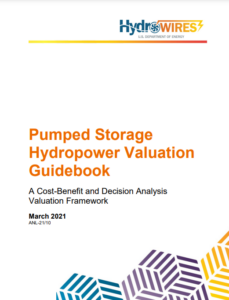Full Title: Pumped Storage Hydropower Valuation Guidebook: A Cost-Benefit and Decision Analysis Valuation Framework
Author(s): Vladimir Koritarov, Patrick Balducci, Todd Levin, Mark Christian, Jongwhan Kwon, Catharina Milostan, Quentin Ploussard, Malhar Padhee, Yuting Tian, Thomas Mosier, S.M. Shafiul Alam, Rojan Bhattarai, Manish Mohanpurkar, Gregory Stark, Dominique Bain, Michael Craig, Boualem Hadjerioua, Patrick O’Connor, Srijib Mukherjee, Kevin Stewart, Xinda Ke, and Mark Weimar
Publisher(s): U.S. Department of Energy
Publication Date: March 22, 2021
Full Text: Download Resource
Description (excerpt):
In April 2019, WPTO launched the HydroWIRES Initiative1 to understand, enable, and improve hydropower and pumped storage hydropower’s (PSH’s) contributions to reliability, resilience, and integration in the rapidly evolving U.S. electricity system. The unique characteristics of hydropower, including PSH, make it well suited to providing a range of storage, generation flexibility, and other grid services to support the cost-effective integration of variable renewable resources.
The U.S. electricity system is rapidly evolving, bringing both opportunities and challenges for the hydropower sector. While increasing deployment of variable renewables such as wind and solar have enabled low-cost, clean energy in many U.S. regions, it has also created a need for resources that can store energy or quickly change their operations to ensure a reliable and resilient grid. Hydropower (including PSH) is not only a supplier of bulk, low-cost, renewable energy but also a source of large-scale flexibility and a force multiplier for other renewable power generation sources. Realizing this potential requires innovation in several areas: understanding value drivers for hydropower under evolving system conditions, describing flexible capabilities and associated trade-offs associated with hydropower meeting system needs, optimizing hydropower operations and planning, and developing innovative technologies that enable hydropower to operate more flexibly.
HydroWIRES is distinguished by its close engagement with the DOE national laboratories. Five national laboratories—Argonne National Laboratory, Idaho National Laboratory, National Renewable Energy Laboratory, Oak Ridge National Laboratory, and Pacific Northwest National Laboratory—work as a team to provide strategic insight and develop connections across the HydroWIRES portfolio as well as broader DOE and national laboratory efforts such as the Grid Modernization Initiative.
Research efforts under the HydroWIRES Initiative are designed to benefit hydropower owners and operators, independent system operators, regional transmission organizations, regulators, original equipment manufacturers, and environmental organizations by developing data, analysis, models, and technology research and development that can improve their capabilities and inform their decisions.
